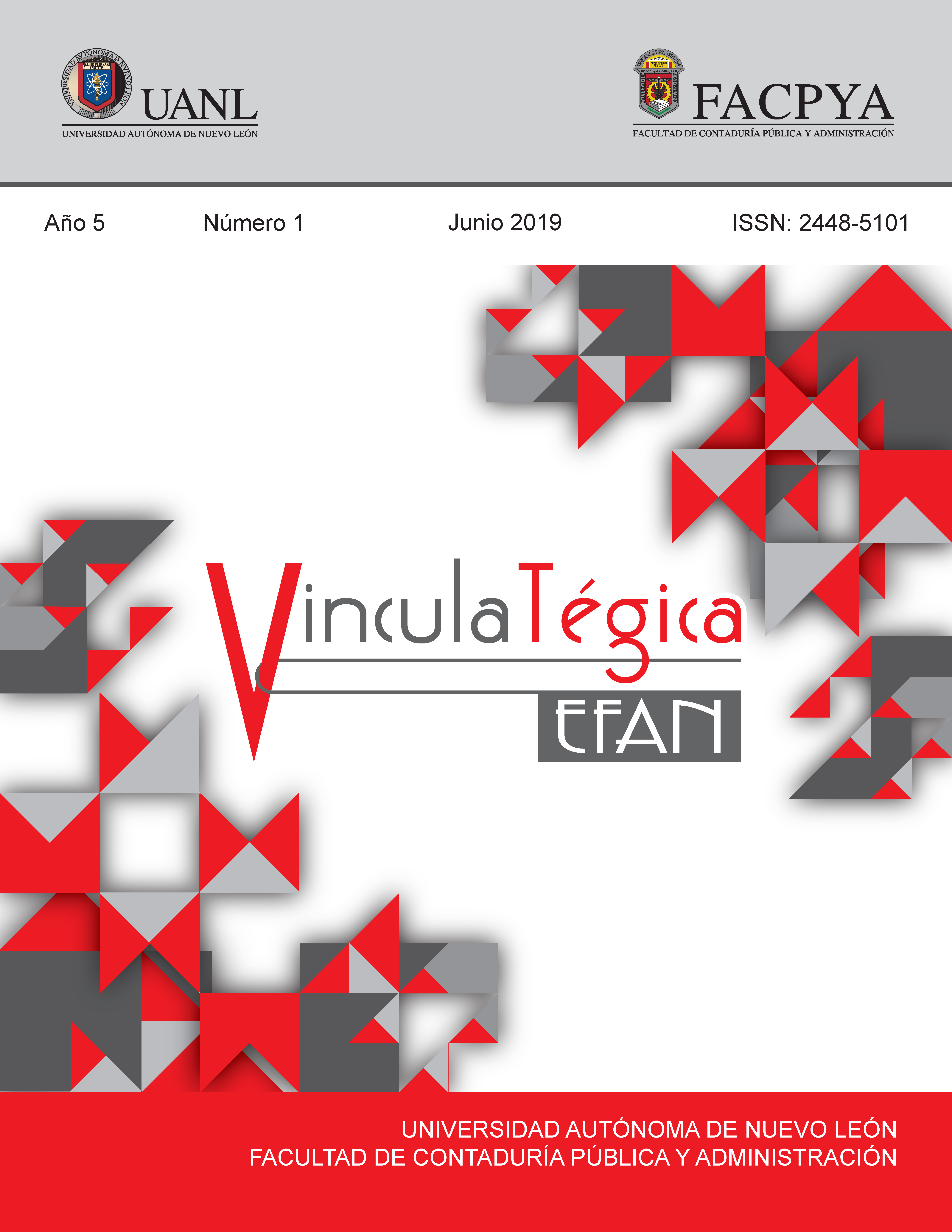Estimación de niveles óptimos de cobertura para portafolios de inversión estáticos, dinámicos y con varianza condicional. Evidencia en países emergentes
DOI:
https://doi.org/10.29105/vtga5.1-776Keywords:
nivel óptimo de cobertura, volatilidad, GARCH, países emergentesAbstract
The purpose of portfolio theory is to optimize the selection of a finite number of financial assets. This technique is a very versatile tool that allows institutional investors evaluate the creation of wealth, diminishing market volatility. This research compares the efficient hedge ratio and the optimal hedge ratio between three models: traditional ordinary least squares, least squares with mobile windows of time and GARCH model. The data employed in this study comprises monthly observations on the MSCI Emerging Market Index, as the spot, and the futures of gold during 2010 to 2018. Our findings reveal that the dynamic model with mobile windows has the grater efficient in hedging and the lowest volatility than the GARCH model.
Downloads
References
Baillie, R. T., & Myers, R. J. (1991). Bivariate GARCH estimation of the optimal commodity futures hedge. Journal of Applied Econometrics, 6(2), 109-124. DOI: https://doi.org/10.1002/jae.3950060202
Basher, S. A., & Sadorsky, P. (2015). Hedging emerging market stock prices with oil, gold, VIX, and bonds: A comparison between DCC, ADCC and GO-GARCH. Energy Economics, 54, 235247. DOI: https://doi.org/10.1016/j.eneco.2015.11.022
Bhattacharya, S., Singh, H., & Alas, R. M. (2011). Optimal Hedge Ratio with Moving Least SquaresAn Empirical Study Using Indian Single Stock Futures Data. International Research Journal of Finance and Economics, 79, 98-111.
Byström, H. N. (2003). The hedging performance of electricity futures on the Nordic power exchange. Applied Economics, 35(1), 1-11. DOI: https://doi.org/10.1080/00036840210138365
Bollerslev, T. (1986). Generalized autoregressive conditional heteroskedasticity. Journal of econometrics, 31(3), 307-327. DOI: https://doi.org/10.1016/0304-4076(86)90063-1
Brooks, C., Henry, O. T., & Persand, G. (2002). The effect of asymmetries on optimal hedge ratios. The Journal of Business, 75(2), 333-352. DOI: https://doi.org/10.1086/338484
Chang, C. L., McAleer, M., & Tansuchat, R. (2013). Conditional correlations and volatility spillovers between crude oil and stock index returns. The North American Journal of Economics and Finance, 25, 116-138. DOI: https://doi.org/10.1016/j.najef.2012.06.002
Creti, A., Joëts, M., & Mignon, V. (2013). On the links between stock and commodity markets' volatility. Energy Economics, 37, 16-28. DOI: https://doi.org/10.1016/j.eneco.2013.01.005
Dickey, D. A., & Fuller, W. A. (1979). Distribution of the estimators for autoregressive time series with a unit root. Journal of the American statistical association, 74(366a), 427-431. DOI: https://doi.org/10.1080/01621459.1979.10482531
Dinică, M. C., & Balea, E. C. (2014). Natural Gas Price Volatility and Optimal Hedge Ratios. Economic Computation & Economic Cybernetics Studies & Research, 48(3).
Ederington, L. H. (1979). The hedging performance of the new futures markets. The Journal of Finance, 34(1), 157-170. DOI: https://doi.org/10.1111/j.1540-6261.1979.tb02077.x
Engle, R. F. (1982). Autoregressive conditional heteroscedasticity with estimates of the variance of United Kingdom inflation. Econometrica: Journal of the Econometric Society, 987-1007. DOI: https://doi.org/10.2307/1912773
Engle, R. F., & Granger, C. W. (1987). Co-integration and error correction: representation, estimation, and testing. Econometrica: Journal of the Econometric Society, 251-276. DOI: https://doi.org/10.2307/1913236
Erb, C. B., & Harvey, C. R. (2006). The strategic and tactical value of commodity futures. Financ Anal J.62,69-97. DOI: https://doi.org/10.2469/faj.v62.n2.4084
Franco, C., & Zakoian, J. (2010). GARCH models, structure, statistical inference and financial application. Wiley London. DOI: https://doi.org/10.1002/9780470670057
García, A., Zabeh, B., Hosein, M., & Rositas, J. (2006). Optimal Hedge Ratio estimation: GARCH (1, 1) approach, a new model). Innovaciones de Negocios, 3(6), 227-242. DOI: https://doi.org/10.29105/rinn3.6-5
Gorton, G., & Rouwenhorst, K. G. (2004). Facts and fantasies about commodity futures (No. w10595). National Bureau of Economic Research. DOI: https://doi.org/10.3386/w10595
Hillier, D., Draper, P., & Faff, R. (2006). Do precious metals shine? An investment perspective. Financial Analysts Journal, 98-106. DOI: https://doi.org/10.2469/faj.v62.n2.4085
Ibbotson Associates, (2006) Strategic Asset Allocation and Commodities, Chicago
Kroner, K. F., & Sultan, J. (1993). Time-varying distributions and dynamic hedging with foreign currency futures. Journal of financial and quantitative analysis, 28(4), 535-551. DOI: https://doi.org/10.2307/2331164
Ku, Y. H. H., Chen, H. C., & Chen, K. H. (2007). On the application of the dynamic conditional correlation model in estimating optimal time-varying hedge ratios. Applied Economics Letters, 14(7), 503-509. DOI: https://doi.org/10.1080/13504850500447331
Lintner, J. (1965). Security prices, risk, and maximal gains from diversification. The journal of finance, 20(4), 587-615. DOI: https://doi.org/10.1111/j.1540-6261.1965.tb02930.x
Markowitz, H. (1959). Portfolio selection. Investment under Uncertainty. 59
Mili, M., & Abid, F. (2004). Optimal hedge ratios estimate: Static vs Dynamic hedging. Finance India, 18, 655.
Mossin, J. (1966). Equilibrium in a capital asset market. Econometrica: Journal of the econometric society, 768-783. DOI: https://doi.org/10.2307/1910098
Myers, R. J., & Thompson, S. R. (1989). Generalized optimal hedge ratio estimation. American Journal of Agricultural Economics, 71(4), 858-868. DOI: https://doi.org/10.2307/1242663
Michaud, R. O., Michaud, R., & Pulvermacher, K. (2006). Gold as a strategic asset. World Gold Council, London 10.
Pástor, L. (2000). Portfolio selection and asset pricing models. The Journal of Finance, 55(1), 179223. DOI: https://doi.org/10.1111/0022-1082.00204
Rondinone, G., & Thomasz, E. O. (2018). Financiarización de commodities: la incidencia de la tasa de interés en el precio del frijol de soya durante el periodo 1990-2014. Revista Análisis Económico, 31(77), 53-83.
Sadorsky, P. (2014). Modeling volatility and correlations between emerging market stock prices and the prices of copper, oil and wheat. Energy Economics, 43, 72-81. DOI: https://doi.org/10.1016/j.eneco.2014.02.014
Sharpe, W. F. (1964). Capital asset prices: A theory of market equilibrium under conditions of risk. The journal of finance, 19(3), 425-442. DOI: https://doi.org/10.1111/j.1540-6261.1964.tb02865.x
Wang, K. M., Lee, Y. M., & Thi, T. B. N. (2011). Time and place where gold acts as an inflation hedge: An application of long-run and short-run threshold model. Economic Modelling, 28(3), 806-819. DOI: https://doi.org/10.1016/j.econmod.2010.10.008
Downloads
Published
How to Cite
Issue
Section
License

This work is licensed under a Creative Commons Attribution 4.0 International License.
a). Authors keep copyright and give the journal the right of the first publication of the work under a Creative Commons attribution license. This license allows others to share the work as long as original authorship and initial publication in this journal is acknowledged.
b). Authors may make other independent and additional contractual agreements for the non-exclusive distribution of the version of the article published in this journal (e.g., include it in an institutional repository or publish it in a book) as long as they clearly indicate that the work was published for the first time in this journal.







